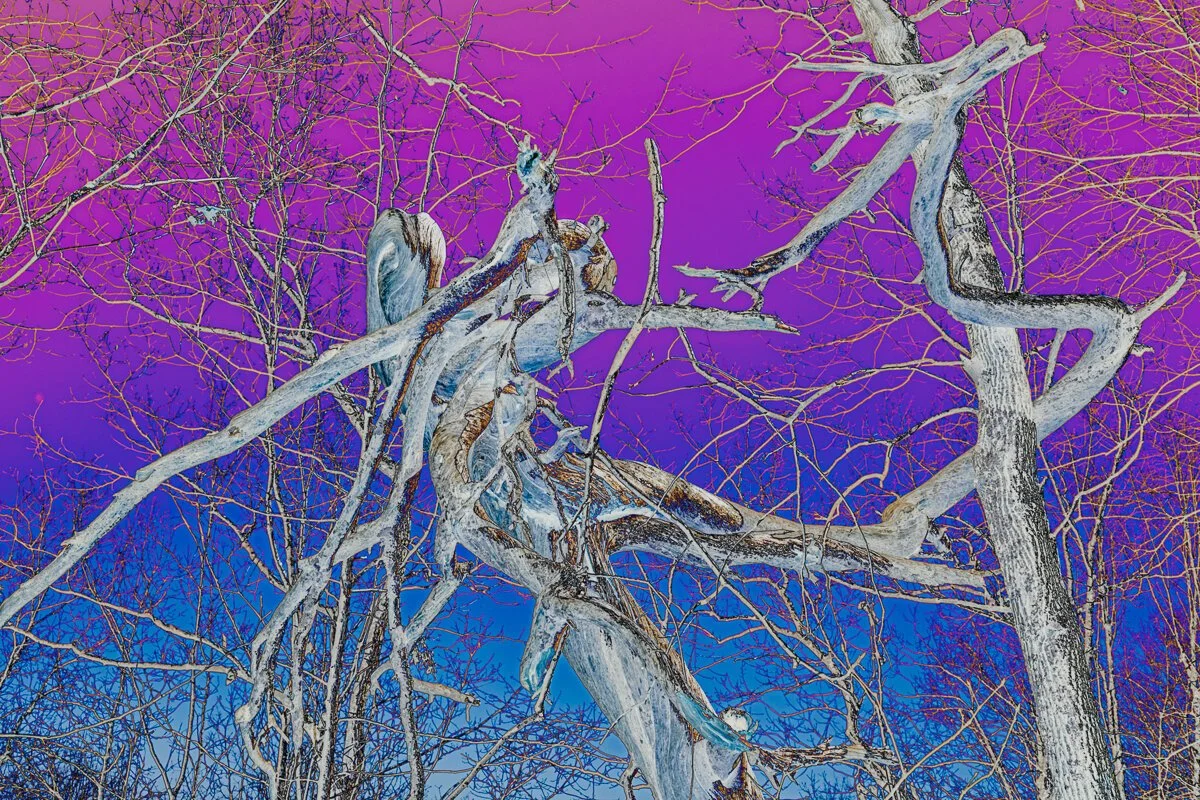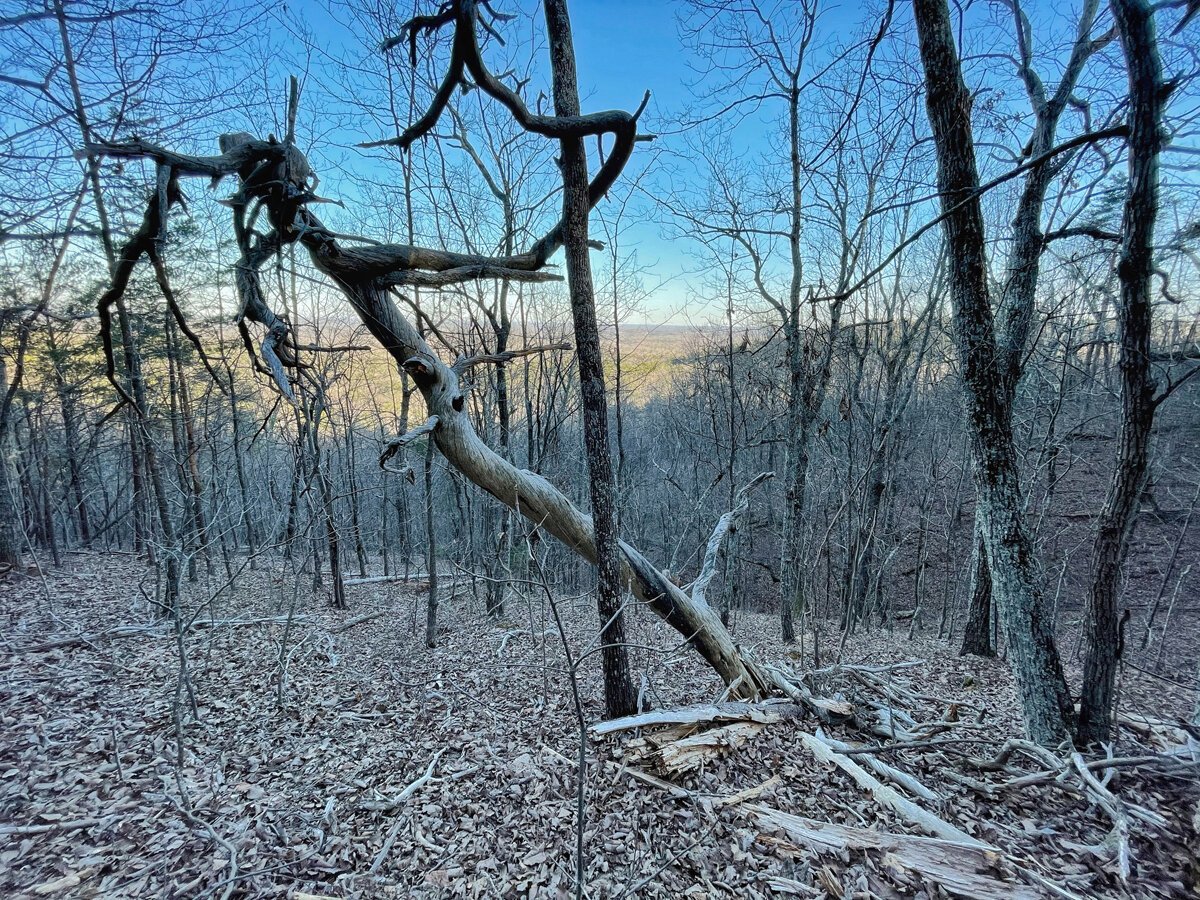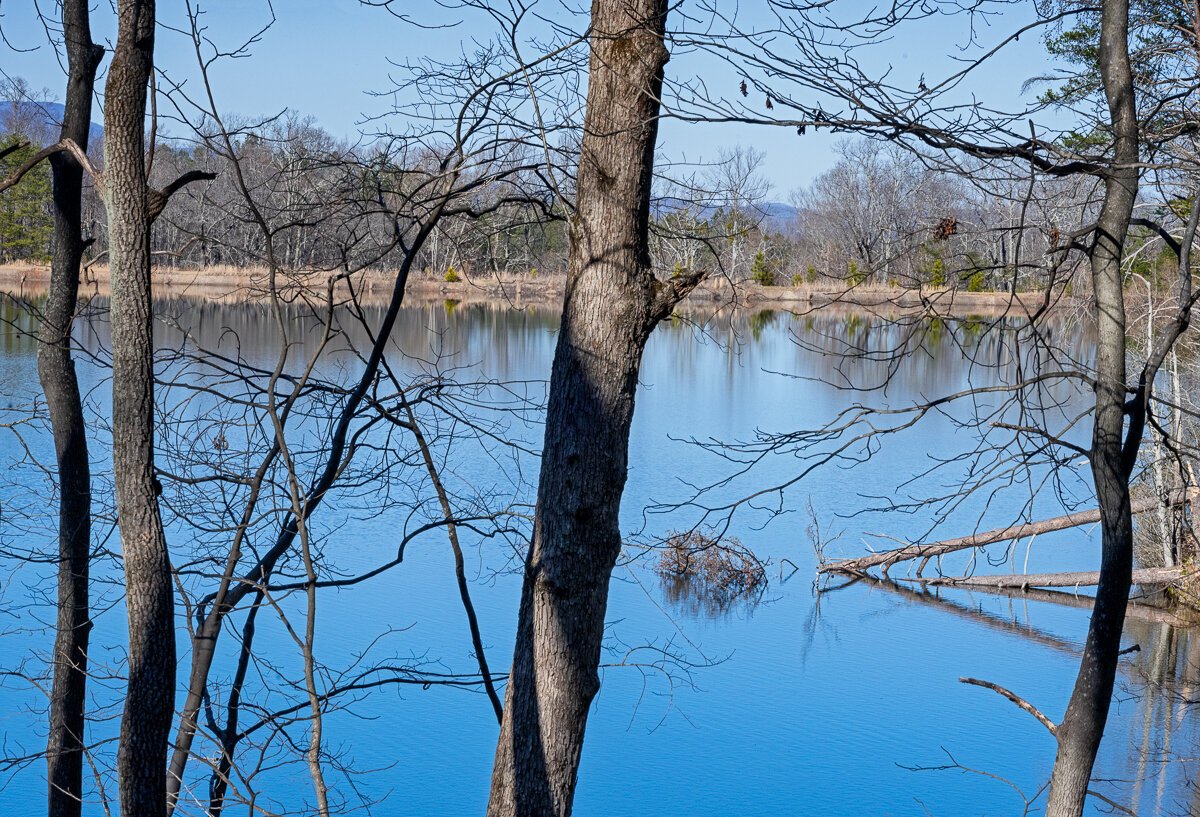Expanding Ways of Seeing on Paris Mountain
Connecting in Every Dimension
Immediately after receiving my second Pfizer vaccine in Columbia, SC, I went hiking with a friend in Greenville. We went to Paris Mountain and hiked the Brissy Ridge Trail and then down to Lake Placid and back up the mountain. In retrospect, it might not have been the best idea given how sick I have been for the past two days. I did not know how badly I would react. Nevertheless, my reaction gave me an inkling of how I might have felt if I had gotten the virus. During and following each trip to get vaccinated, my thoughts have naturally focused on life and death and how grateful I am that we live in a time when vaccines can be produced to combat pandemics. When I came upon these two trees engaged in their own dialog about life and death, I immediately stopped and studied them from many angles. What really struck me was how the dying tree had curled it’s limb around the one that was still standing in an effort to prolong it’s verticality and existence, before it crashed to the ground and was broken down by fungi so as to provide energy for new life. Multiple dimensions of existence were interconnected in this odd embrace.
Swooning Dying Tree
Near the end of our hike, as dusk was approaching, we encountered these trees again. The one on the left looked like it was swooning. For the past three and a half years, I have been a part-time caregiver for my mother. As she has become frailer and frailer, she went from reaching out to me for a steadying hand to relying on me and her walker at all times to hold herself upright. Often, especially following windstorms, I have seen a falling tree caught in another tree in the V formed where branches connect to the trunk. Yet, I have never seen a branch curl around in this way, almost as if it had anticipated that it wouldn’t remain vertical for much longer and that it needed to do this to one day grasp on to the only nearby support. We often talk of humans knowing that the end is near and how people should get their affairs in order, but this made me wonder if trees know their time is coming too and make their own preparations..
Rhythm of the Lake
We took the Kanuga Trail down to Lake Placid and it truly was just that. The water was so still and blue and seeing it immediately made me feel calmer. Paris Mountain is a monadnock, which means it stands alone. That means it is also exposed to the elements without protection and consequently there are many downed trees. One of them is visible in the lake. The park was built by the Civilian Conservation Corp back in the Great Depression. This fact reminded me of the value of park projects, improving infrastructure, and other government supported projects during troubled times.
Dead Trees in the Lake
Throughout much of my early life, I believed nature would be improved if it were cleaned up and dead trees were removed to make wilderness areas more aesthetic. Although we generally think of living trees as more beautiful, dead trees play a very important role in the cycle of life and they still provide energy to the forest long after they are no longer standing. I felt the power of the vertical lines and the roots, though they were exposed and hovered over the water instead of penetrating the earth, so I processed the image to emphasize the currents of energy that still existed..
Psychedelic Reflections
The tree that formed the above reflection hadn’t fallen yet. It had only died recently, which was evident from the brown leaves still clinging to the branches. Its energy vibrated more intensely and colorfully and I processed it using my psychedelic technique to convey the life force I still felt emanating from it. This way of processing images stops me from assigning labels, such as dead tree by the lake, and then dismissing what I see as something known, ordinary, or even undesirable. Lately, I have been more interested in discovering more poetic ways of seeing that focus on uniqueness and only arrive at categories last if it all. I want to keep the preciousness of life in the forefront. Rather than celebrating nature only when it is at the peak of perfection, I want to express gratitude for every moment in the cycle of life.
The Lure of the Lake
Most vantage points of the lake were framed by trees and though they provided visual interest, it was the lake that drew me into the scene. How I longed to dive into the mystery of its waters. There is always so much below the surface. When I was a child, I had this strange feeling that every time we drove by a lake, whoever was driving the car or the car itself would magnetically be drawn to the water and my family and I would all drown. Lakes had an irresistible allure to me, despite their lurking dangers. The unknown has a way of beckoning us and if we are not careful, we lose our bearings. The unconscious can replenish us, but it can destroy our egos too. Sometimes that can be positive, when it leads to awakening or rebirth, something our society is in need of now.
A Ring of Moss Around a Rock Seepage
Life cannot exist without water, and when it is clean and pure moss and plants spring up all around streams and seeps. I was particularly drawn to the unusual and delicate flat ferns that almost seem etched onto the rock in the foreground. Nature provides the most interesting patterns. Nothing is ever perfectly straight, as life is a dance involving symbiotic exchanges or at least continually shifting adaptations by life forms to the biosphere. Nature does not insist, as we human’s often do, that things should remain the same or that control instead of cooperation is a workable paradigm.
Moss Patterns in the Light
Usually, when I see moss, I am immediately captivated by its rich green color, especially in winter when everything is so drab and brown. This moss seemed so tactile and alive that I wanted to focus on its structure rather than its seductive color. The shifting patterns and the way the light was hitting it created swirls of energy and revealed nature’s own patterning instinct. Humans, philosophers tell us, have pattering instincts to make sense of the world that we live in. But when I am on mediative walks, i am not trying to impose my understanding on nature. Rather I am waiting to see what revelations nature gifts me with. These patterns seemed too intricate to be entirely random. The reminded me of the flight paths of flocks of birds, moving together and apart in an orchestrated way. There is so much we don’t know about non-human life forms, especially plants, trees, and fungi, and how they function together. Fortunately, we are gifted with the ability to make scientific observations and the ability to see poetically. Learning to use the two togtether may provide us with new insights on how to live cooperatively and sustainably.








